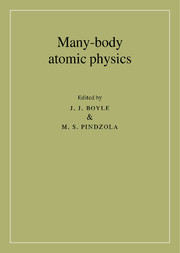Book contents
- Front Matter
- Contents
- Foreword
- Contributors
- Preface
- Acknowledgements
- Part 1 ATOMIC STRUCTURE
- 1 Development of atomic many-body theory
- 2 Relativistic many-body perturbation theory for highly charged ions
- 3 Parity nonconservation in atoms
- Part 2 PHOTOIONIZATION OF ATOMS
- Part 3 ATOMIC SCATTERING: A. General Considerations
- Part 3 ATOMIC SCATTERING: B. Low-order applications
- Part 3 ATOMIC SCATTERING: C. All-order applications
- Appendix: Units and notation
- References
- Index
2 - Relativistic many-body perturbation theory for highly charged ions
Published online by Cambridge University Press: 22 September 2009
- Front Matter
- Contents
- Foreword
- Contributors
- Preface
- Acknowledgements
- Part 1 ATOMIC STRUCTURE
- 1 Development of atomic many-body theory
- 2 Relativistic many-body perturbation theory for highly charged ions
- 3 Parity nonconservation in atoms
- Part 2 PHOTOIONIZATION OF ATOMS
- Part 3 ATOMIC SCATTERING: A. General Considerations
- Part 3 ATOMIC SCATTERING: B. Low-order applications
- Part 3 ATOMIC SCATTERING: C. All-order applications
- Appendix: Units and notation
- References
- Index
Summary
Introduction
In the thirty years since Kelly's seminal papers appeared in print, many-body perturbation theory has become one of the most important and widely used methods for determining energy levels and properties of atoms. The theory has developed in two directions during recent years. Firstly, it has been extended to include infinite classes of terms in the perturbation expansion using coupled-cluster and other all-order methods. These extensions were discussed in the first chapter of this book. Secondly, the theory has been modified to include relativistic corrections in an ab initio way starting from the Dirac equation. Kelly contributed to both of these extensions; indeed, two of his recent papers were devoted to relativistic all-order methods.
Relativistic many-body theory is based on the no-pair Hamiltonian, an approximate Hamiltonian derived from QED by ignoring the effects of virtual electron-positron pairs, The no-pair Hamiltonian accounts for the electron-electron Coulomb interaction and the Breit interaction, but does not include QED effects such as the electron self-energy and vacuum-polarization. Relativistic atomic structure calculations based strictly on QED are difficult if not intractable; they have been carried out only for the simplest many-electron atom, helium. The dominant QED corrections to energies of many-electron atoms have been evaluated in a few cases; however, a systematic account of QED corrections to the no-pair Hamiltonian has not as yet been given for atoms other than helium.
Multiconfiguration Dirac-Fock (MCDF) methods are also extensively used to determine energy levels of relativistic atomic systems.
- Type
- Chapter
- Information
- Many-Body Atomic Physics , pp. 39 - 64Publisher: Cambridge University PressPrint publication year: 1998
- 16
- Cited by



